623 Teckels
TECKELLING YOUR FANCY
by David Hancock
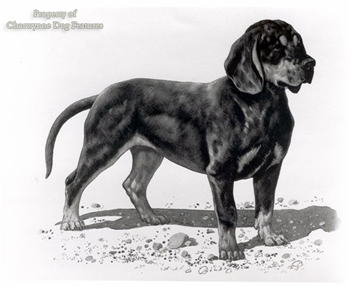 Terriers as earthdogs are very much a British creation. although pinschers and schnauzers, and especially the German Hunt Terrier, are terrier-type. But the Dachshund, classified by the Kennel Club as a hound, (perhaps mistakenly believing 'hund' to be our word 'hound'), in its working role or Teckel use, is very terrier in function. Much is made in show dog histories of the Dachshund of clandestine terrier blood infusions, especially the Dandie Dinmont contribution, but I can find no proven use of terrier blood in the creation of the Dachshund. The development of the wire-hair was aided in 1925 from Dandie blood by Lt Klaus Graf Hahn of Potsdam. But the centre of working use was the Harz mountains, where Dachswurgers (badger-destroyers) were treasured and reference to a Lockhundlein or little decoy dog intriguingly made.
Terriers as earthdogs are very much a British creation. although pinschers and schnauzers, and especially the German Hunt Terrier, are terrier-type. But the Dachshund, classified by the Kennel Club as a hound, (perhaps mistakenly believing 'hund' to be our word 'hound'), in its working role or Teckel use, is very terrier in function. Much is made in show dog histories of the Dachshund of clandestine terrier blood infusions, especially the Dandie Dinmont contribution, but I can find no proven use of terrier blood in the creation of the Dachshund. The development of the wire-hair was aided in 1925 from Dandie blood by Lt Klaus Graf Hahn of Potsdam. But the centre of working use was the Harz mountains, where Dachswurgers (badger-destroyers) were treasured and reference to a Lockhundlein or little decoy dog intriguingly made.
What is far more compelling is a descent from German foothounds, like the Dachsbracke. In the early 1800s, a Prussian forester called von Daacke was increasing the Dachshund's scenting ability by outcrossing to his Hanoverian Schweisshunds, producing red dogs with black masks and an eel stripe along their backs.![]()
Small foothounds were favourite sporting dogs in western and central Europe in past centuries: the Drever in Sweden, the Steenbrak in Holland, the Sauerland Hound or Steinbracke, as well as the Dachsbracke, in Germany and the Jura Niederlaufhund in Switzerland. There is a variety called the Alpine Dachsbracke, found in the Erzgebirge Mountains near the Czech border, known locally as the 'Erzgebirgler', usually in a rich tan. Most of the Swiss hound breeds have a smaller shorter-legged niederlaufhund variety, illustrating the genetic tendency in these foothounds. Our English Basset, bred by the packs and the result of a Harrier outcross, is our equivalent hunting hound.
As the Basset Hound demonstrates, these small hounds can throw crooked-legged dwarf offspring, with the show ringfavouring the latter and sportsmen going for the straightlegged variety. The Dachsbracke, or Badger Hound, represents the latter, the Dachshund or Badger Dog representing the former. Crooked-legged dwarfism is a genetic freak, anabnormality called achondroplasia, inheritedrecessively. As breed depictions indicate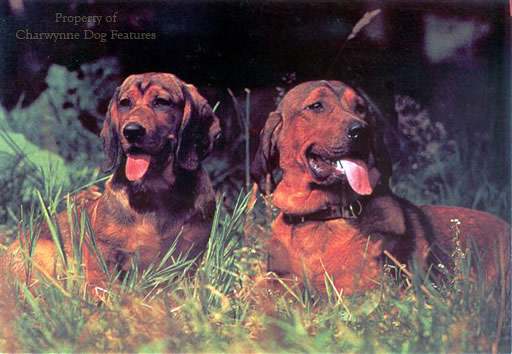 down the years, such a genetic sidetrack in time exaggerates itself, leading to the harmful elongated backs and the disabling legs of the show ring specimens. Dachshunds are the only breed with the shoulders positioned so high above the brisket or keel, as breed fanciers like to term it. The Dachshund is predisposed to intervertebral disc disease becuase of its conformation, with disc disease occuring in young dogs as well as a geriatric condition.
down the years, such a genetic sidetrack in time exaggerates itself, leading to the harmful elongated backs and the disabling legs of the show ring specimens. Dachshunds are the only breed with the shoulders positioned so high above the brisket or keel, as breed fanciers like to term it. The Dachshund is predisposed to intervertebral disc disease becuase of its conformation, with disc disease occuring in young dogs as well as a geriatric condition.
Described in its sporting past as a Dachskrieger or Badger-warrior, with the lower to ground specimens called Dachskriecher or Badger-creeper, any Dachshund would have to be some dog, physically and in spirit to tackle a badger. Every earthdog needs remarkable agility to work underground, both to manoevre and to dig. The anatomy of the show ring specimens would preclude such activity alone. Hunt terriers tend to be 12 to 14 inches at the shoulder and weigh around 14lbs, because that is what enables their function. The ideal weight for a Dachshund is 20-26lbs, with the miniature varieties being 10lbs; not much for badgers to fear there! For a 10lb dog, practically legless and with an exaggerated weakened spine, to be called a 'badger-dog' is absurd. 'Badger-breakfast' would be more accurate!
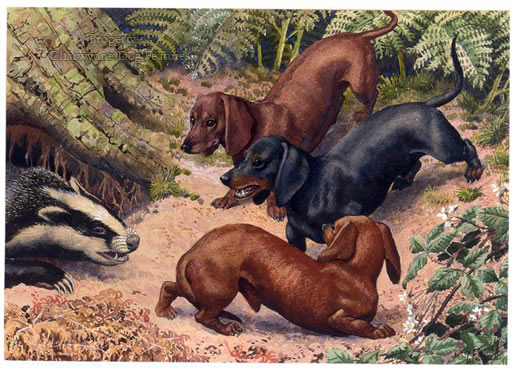 Encouragement comes in the form of the Teckel, the sporting Dachshund, so like a shorter-legged Basset Fauve de Bretagne, or chestnut Basset of Brittany, a most engaging little hound. Teckels have been used extensively for deer work, both in stalking and tracking. They were introduced to the UK in the 1970s, with the UK Teckel Stud Book Society founded in 1999. There are over 580 Teckels registered with the society to date. The Ryeford Chase is a private pack of 30 couple Griffon Vendeen Bassets and uniquely 10 couple Teckels, started in 1974and willing to hunt all over the country. I have heard the smaller Teckels described as Dachsels or Kaninchen, used as rabbit dogs, on the continent, where nine distinct tests are conducted to test hunting skills, including a water trial. The wire-haired variety is favoured by hunters from Poland to Slovenia. Colours recognised by the Stud Book Society are black and tan, chocolate and tan, red, brindle and dapple.
Encouragement comes in the form of the Teckel, the sporting Dachshund, so like a shorter-legged Basset Fauve de Bretagne, or chestnut Basset of Brittany, a most engaging little hound. Teckels have been used extensively for deer work, both in stalking and tracking. They were introduced to the UK in the 1970s, with the UK Teckel Stud Book Society founded in 1999. There are over 580 Teckels registered with the society to date. The Ryeford Chase is a private pack of 30 couple Griffon Vendeen Bassets and uniquely 10 couple Teckels, started in 1974and willing to hunt all over the country. I have heard the smaller Teckels described as Dachsels or Kaninchen, used as rabbit dogs, on the continent, where nine distinct tests are conducted to test hunting skills, including a water trial. The wire-haired variety is favoured by hunters from Poland to Slovenia. Colours recognised by the Stud Book Society are black and tan, chocolate and tan, red, brindle and dapple.
The vast majority of the UK Teckels are used for deer work and so most of the nine working tests don't apply but their existence displays a commendable genuine desire to perpetuate a working breed. The German working tests include ones for gunshynes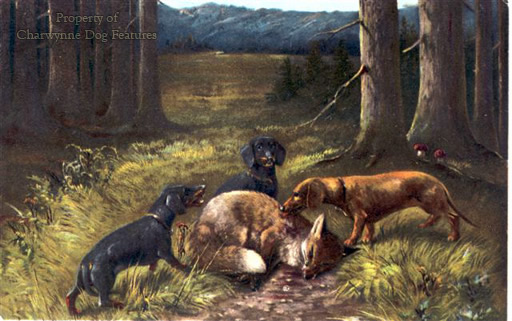 s, underground work (hold at bay not kill), tracking a 1000 metre boar blood trail and specific tests to bay boar, deer and fox. Earthdog tests are conducted both in France and North America, designed to test terriers and Teckels under the ground using tunnels, pipes and artificial burrows. Earthdog tests in the US involve a junior (instinct) test, where the dog has to traverse a 30 foot-long, wood-lined, underground tunnel with three 90 degree turns and 'work' the prey (caged rats) for at least 60 seconds. There are more realistic tests for the Senior and Master Earthdog titles. Could we not copy these?
s, underground work (hold at bay not kill), tracking a 1000 metre boar blood trail and specific tests to bay boar, deer and fox. Earthdog tests are conducted both in France and North America, designed to test terriers and Teckels under the ground using tunnels, pipes and artificial burrows. Earthdog tests in the US involve a junior (instinct) test, where the dog has to traverse a 30 foot-long, wood-lined, underground tunnel with three 90 degree turns and 'work' the prey (caged rats) for at least 60 seconds. There are more realistic tests for the Senior and Master Earthdog titles. Could we not copy these?
My concern over long-backed short-legged dogs, the exaggerated show specimens rather than the Teckels, relates to the strain on their spines on the move. Unlike longer-legged shorter-backed breeds, the dog's weight is not supported continuously by the legs. The hind legs are just not long enough to place the hind feet close to the fore feet, as locomotion proceeds. The spine therefore bears the weight unsupported and the consequent strain must be appreciable. Vets complain of seeing Dachshunds in their surgeries only a year old but with 'five year old' spines. 'Sausage dogs' can be endearing to many, but back pain to all is best avoided, and could so easily be, in this breed - by breeding for a shorter back and lengthier legs. It's called animal welfare!
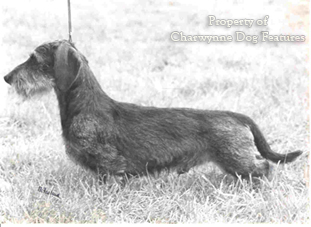 |
 |
|
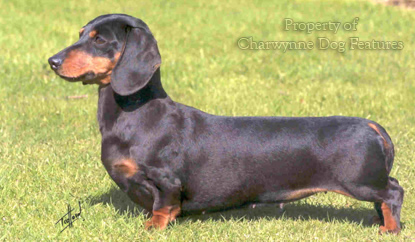 |
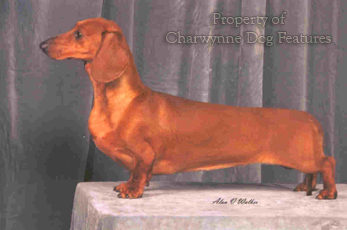 |